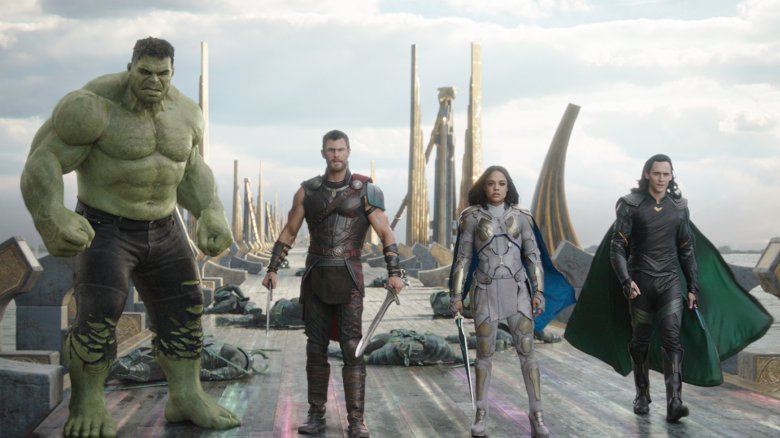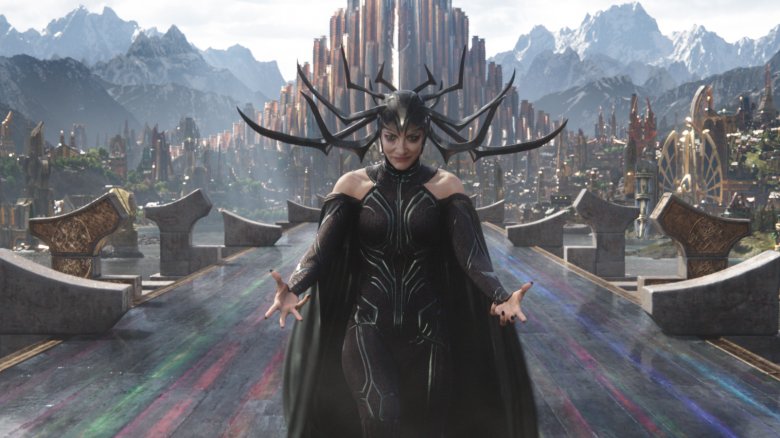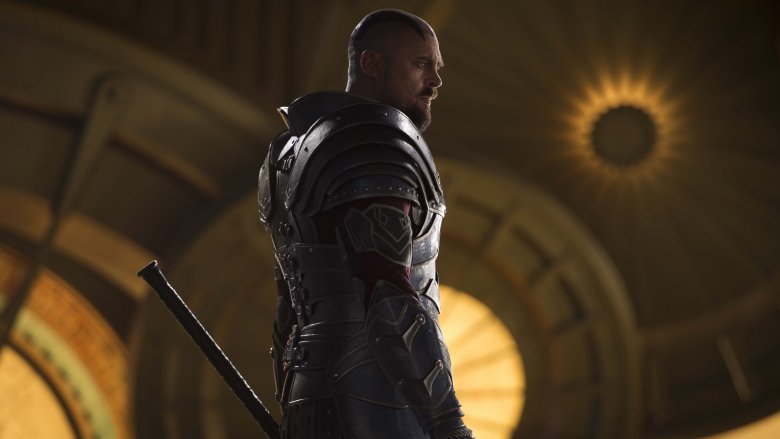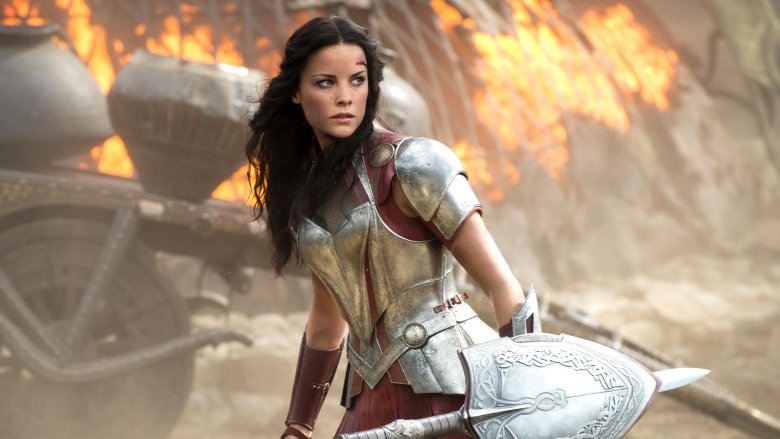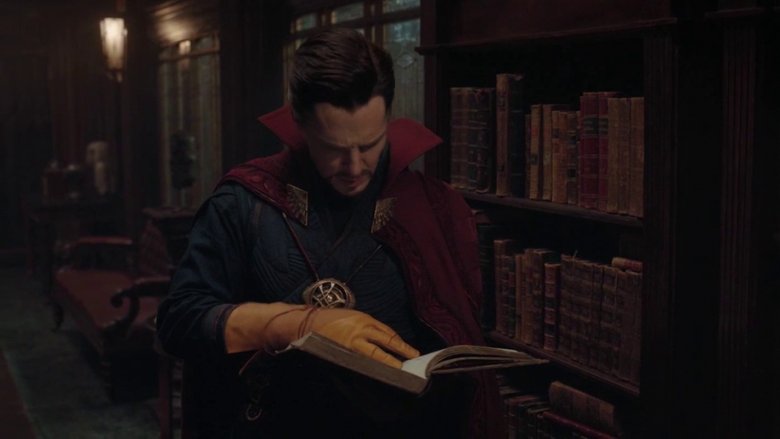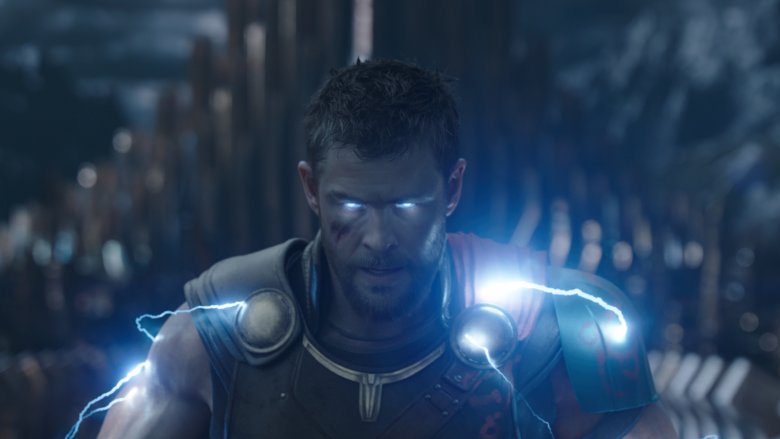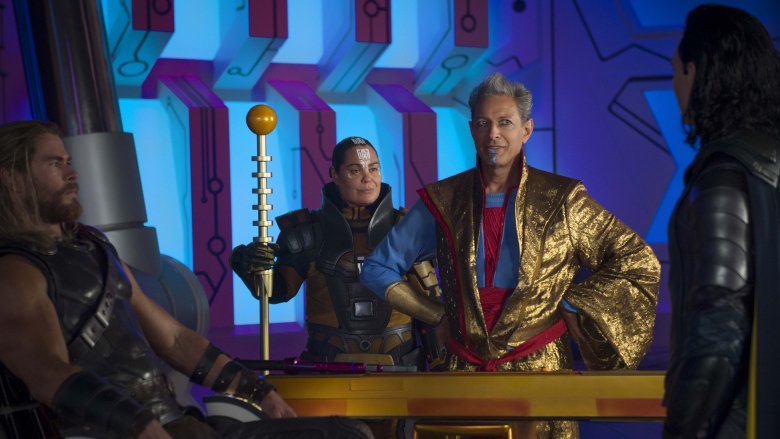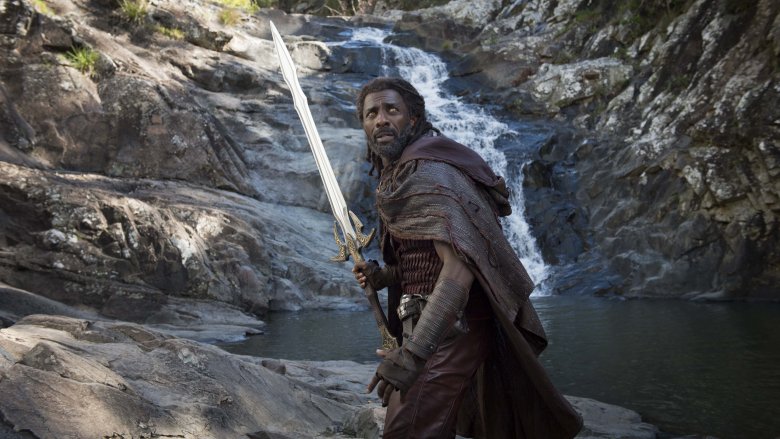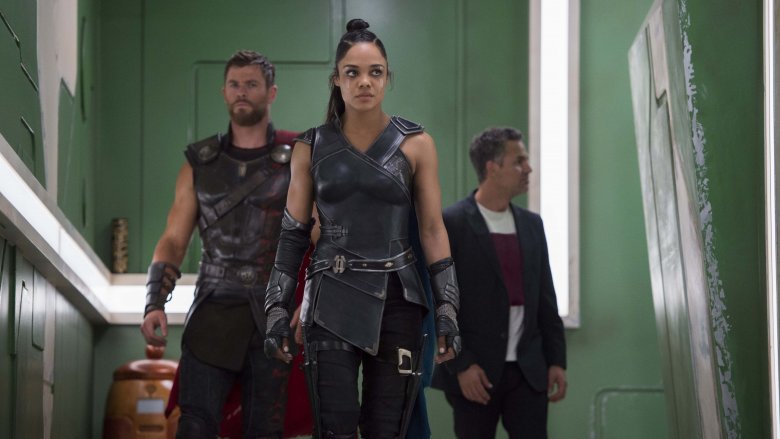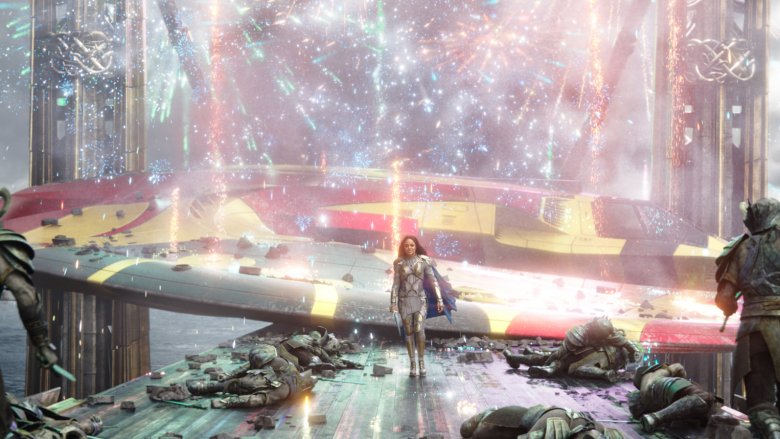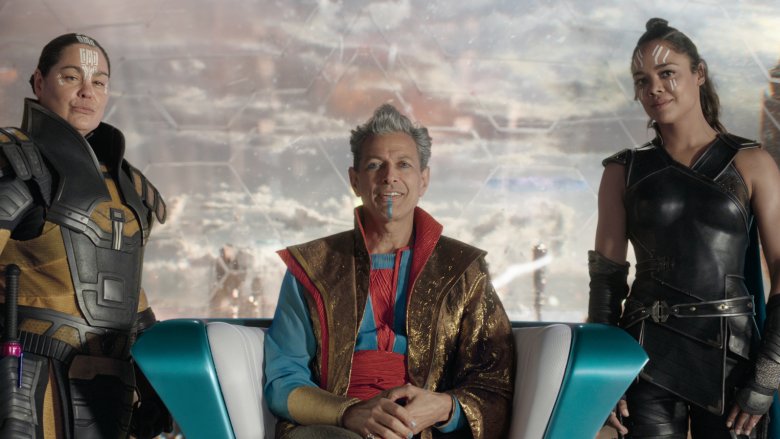Thor: Ragnarok Details That Only Adults Notice
With 2017's Thor: Ragnarok, director Taika Waititi took audiences on a strange cosmic journey with the God of Thunder — and gave us something completely different from the previous two Thor films while showing us places and characters unlike anything else in the Marvel Cinematic Universe.
Even if you're a longtime Marvel fan and familiar with the comics that helped inspire it, Ragnarok can sometimes feel overwhelming with its all-out visual and comedic assault, to the point that on the first or even second or third watch there are going to be plenty of things you don't pick up on — particularly if you're a younger viewer just trying to follow the superhero hijinks. That's where we come in. From the structure of Sakaaran society to how you get to and from Asgard, here are a few things only adults tend to notice in the third Thor adventure.
**SPOILERS AHEAD for Thor: Ragnarok**
Odin is really bad at hiding things
The key villain for most of Ragnarok is Hela, the Goddess of Death (Cate Blanchett) who also happens to be Thor (Chris Hemsworth) and Loki's (Tom Hiddleston) older sister, and the oldest child of Odin (Anthony Hopkins). Hela, it turns out, helped Odin conquer and plunder various realms in days of old, until he decided she'd gone too far and decided to banish her. With Ragnarok approaching along with Odin's death, she returns to take back "her" kingdom, and reveals — among other things — a massive mural commemorating her past success hidden in the ceiling. This is all news to both Thor and Loki, and highlights a continuous problem on Asgard: Odin is really bad at keeping things hidden. In the first Thor, it was the secret of Loki's Frost Giant birth. In the second, it turns out there was a secret portal out of Asgard. Now here comes a daughter that he apparently never told his sons about, or at least never told them everything she'd done before her banishment. Odin was clearly a ruler who liked to present a certain image of himself and his kingdom, but in order to do that you have to make sure the truth is secure. Odin seems to have never been very good at the latter part.
Skurge is probably a suspect in a lot of Earth crimes
As Ragnarok begins, Loki rules Asgard while disguised as Odin, having banished the real Allfather to Earth during the events of Thor: The Dark World. One of his early acts as king, after Thor was safely out of town, was apparently to accuse Heimdall (Idris Elba) of treason and appoint Skurge (Karl Urban) as the new guardian of the Bifrost, the Rainbow Bridge linking Asgard to the other Nine Realms. Skurge, considerably less honorable than Heimdall, uses his new gig to accumulate a lot of "stuff" from Earth, ranging from guns and ninja swords to Shake Weights. When you stop and think about it for a second, though, his collection means that a large Asgardian man wearing armor from another world has been frequently dropping in on Earth, just taking stuff (unless he somehow legitimately got his hands on some Earth money) and bringing it back to Asgard. Given the level of surveillance in our society, someone is bound to have reported him at some point. If he'd ever visited the same place twice, he might have been arrested.
Lady Sif is gone, and no one seems to care
Ragnarok is a departure from the other Thor films in many ways, not the least of which is that it leaves out two major women in Thor's life. Jane Foster, Thor's love interest in the first two Thor films, is explained away by having a woman on Earth mention that Jane and Thor broke up, thus relieving star Natalie Portman of her duties. Lady Sif, Thor's Asgardian ally who was also teased as a potential love interest, isn't handled so cleanly. Sif has significant roles to play in the first two films, but aside from an actress playing her in the drama Loki stages commemorating his own death, she's never mentioned in Ragnarok. While there are certainly plenty of other things to focus on in the film, it's a bit jarring. Apparently the real-life reason for her absence is that star Jaimie Alexander had a scheduling conflict, and her future in the MCU seems murky. According to Avengers: Infinity War directors Joe and Anthony Russo, she's one of the offscreen characters who didn't survive that film.
Who else is Doctor Strange keeping track of?
Though the film spends less time on Earth than either previous Thor adventure, Ragnarok does depict Thor and Loki's unexpected encounter with Doctor Strange (Benedict Cumberbatch), who traps Loki in a pocket dimension while he has a chat with Thor about why they've come to Earth. Strange explains to the God of Thunder that he keeps a "watchlist of individuals and beings from other realms that may be a threat to this world," and Loki is on it. That's what you get when you try to conquer the world with an alien army.
It's a fun little scene that's mostly there so we can have a little more MCU interconnectedness and spend a bit of time with Strange, but it also makes you wonder. As a Master of the Mystic Arts, it's Strange's duty to protect Earth from various threats, so the list itself makes sense, but who else is on it? Has Strange noticed Skurge using the Bifrost to steal things? Plus, he doesn't say he only keeps track of beings that come to Earth. He keeps track of beings who "may be a threat," so does Hela show up on his radar during the film? We don't know, but we're betting we haven't heard the last of that list in the MCU.
For the God of Thunder, Thor gets shocked an awful lot
In addition to extreme strength, durability and a lifespan much longer than that of a human, Thor is the God of Thunder, which means he can call down and channel lightning at will. Up until Ragnarok, he does this with the aid of his hammer, Mjolnir, but when that hammer is destroyed by Hela, he's forced to reckon with his power anew, and learns from Odin that it comes not from the hammer but from within himself. By the end of the film, Thor is calling down massive lightning strikes, and even when he's imprisoned on Sakaar he's able to manage a few sparks. So if his body is naturally gifted with the power to channel lightning, why is he so vulnerable to shocks? He gets shocked by a net thrown on him by scavengers when he first arrives on Sakaar, and then is repeatedly zapped by the neck implant placed on him by Valkyrie after she captures him. Granted, the zaps coming from these devices might not be electricity as we know it, but it's still weird to hear the tell-tale sound effects and watch Thor tremble in one scene, then pull a lightning storm out of the sky in another.
Sakaaran society is a little murky
After a run-in with Hela, Thor and Loki are sent spinning out of the Bifrost until they separately fall through portals on Sakaar, a planet at "the edge of the known and unknown" that is "the collection point for all lost and unloved things." Sakaar is basically a land of refuse, and at the center is a city dominated by an arena and the palace of its ruler, the Grandmaster (Jeff Goldblum). Grandmaster presides over the Contest of Champions, a massive set of gladiator-style fights Thor and many others are forced to participate in. He also employs a variety of scavengers and bounty hunters called "scrappers," such as Valkyrie (Tessa Thompson). Valkyrie and the introductory voice both tell Thor "no one leaves this place," which makes it a bit puzzling when you think about Grandmaster's money (which he happily pays out to Valkyrie) and his many apparent guests. Where do they all come from? Do they have homes to return to? How does Sakaaran money work out here at the edge of space?
Heimdall's powers are still really imprecise
Heimdall is a key player in all three of Thor's solo adventures in the MCU, yet it's tough to get a handle on exactly how far his powers reach or when they work. In addition to guarding the Bifrost and wielding the sword that opens and closes it, he can apparently see almost anyone in any realm, with a few exceptions, and he's capable of responding to Thor's requests for transport within seconds. When he's on Sakaar, Thor takes advantage of this, calling out to Heimdall to not only see where he is, but see what's happening on Asgard through Heimdall's eyes. Heimdall, meanwhile, is in hiding on Asgard leading a resistance against Hela, and has stolen the Bifrost sword in the hope that he can get the Asgardian refugees to safety. The lingering question: Why didn't Heimdall seek out Thor when he was forced into hiding after Loki-as-Odin accused him of treason? Why didn't he look for Thor after Hela took over? Did he have to have the sword to see Thor? It doesn't seem so, because Thor called out to him when he had no way of knowing that Heimdall had the sword back in the first place. Heimdall is one of the MCU's eternal mysteries.
Valkyrie has a pretty serious drinking problem
The first time we meet Valkyrie, she falls off her ship after taking a big drink. The moment is played for laughs, as are other moments involving Valkyrie and alcohol, but as the story plays out we get a clearer picture of exactly what's going on with her. As a Valkyrie, she fought alongside her sisters the last time Hela tried to rule Asgard, and she was left alone and shattered by the experience. She fled her home, found her way to Sakaar, and basically took up a life that would allow her to do nothing but earn money and drink all day. Until the end of the film, when she's happily fighting alongside Thor and Hulk, we rarely see her without a drink in hand. While much of the movie treats that as though she's simply some kind of slacker more concerned with having a good time than anything else, when viewed as a whole Ragnarok presents a tragic view of a woman who wants to drink herself into oblivion.
How to get to or leave Asgard can be anything you want
In the first Thor film, getting to and from Asgard is laid out simply: You leave via the Bifrost, and you get back by calling to Heimdall and asking him to pull you back...via the Bifrost. That's pretty much it, which is why it feels so tragic when the Rainbow Bridge is destroyed at the end of that film. Later, it's established that there are other ways to travel, including secret portals. By the time we get to Ragnarok, all bets are off. Thor, Banner, and Valkyrie get there through a giant wormhole while flying in a spaceship, then Korg and the other rebellious Sakaarans follow. When it's time for everyone to leave Asgard again, they all just jump on the big ship stolen from the Grandmaster's hangar. Granted, the rules of Asgardian travel no longer apply when there's no more Asgard, but even with that in mind the film takes a rather loose approach to any sense of rules about how you get to and from the realm. Perhaps it's for the best in the movie that burns it all down anyway.
A way out for Infinity War
This isn't something you'd notice while watching Ragnarok the first time, but in the current climate of the Marvel Cinematic Universe it's something worth drawing attention to, even if it turns out to mean nothing. Avengers: Infinity War begins shortly after Ragnarok left off, with the Asgardian refugee ship savaged by Thanos and his children. In the carnage, we see the loss of numerous Asgardians, but we don't know anything about what happened to Valkyrie or Korg. All we're left as a clue is Thor's declaration that Thanos slaughtered half of his people, as is his custom. Presumably the other half is still out there in space somewhere, but where? We might not know the answer for some time, but if you look closely at one of Ragnarok's final shots, you'll see the Grandmaster's pleasure cruise vessel, battered but still recognizable, parked on top of the larger ship. It couldn't have taken half the refugees with it, but if Valkyrie was crafty enough she could have easily hopped aboard and escaped with a few friends in tow. Just something to think about...
